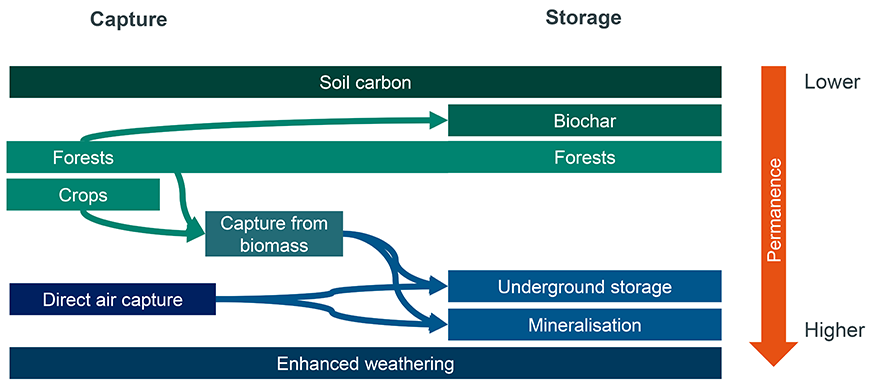This paper examines the broad policy frameworks that can support the development and upscaling of Carbon Dioxide Removal (CDR) without diverting attention from ambitious greenhouse gas emissions reductions and, in particular, whether CDR can be supported by offsetting schemes. Setting separate emission reduction and removal targets may be a way to achieve this. The paper was funded by the Carnegie Climate Governance Initiative (C2G), which is an initiative of the Carnegie Council for Ethics and International Affairs.
Context and approach:
The special report on the 1.5°C temperature limit by the Intergovernmental Panel on Climate Change (IPCC, 2018) unambiguously states that meeting a 1.5°C warming scenario with no temperature overshoot will require significant carbon dioxide removal (CDR). While aggressive and expedient mitigation actions remain the first priority and absolutely critical, it is also imperative to simultaneously explore and develop CDR options so that they are available at the scale required to achieve global net-negative CO2 emissions in the second half of the century. The challenge of upscaling CDR provokes many technical, societal, and governance questions and challenges.
In this paper we set out to examine the broad policy frameworks that can support the development and upscaling of CDR and, in particular, whether CDR can be supported by offsetting schemes. Our analysis begins by characterising some of the most prominent and promising approaches to CDR in terms of the costs, technological maturity, removal and storage potential, as well as potential risks and co-benefits. We then examine the types of support that these approaches would need at different stages of development and collate examples of policies and activities currently in place. Finally, we explore the broader types of policy frameworks that are required to signal and financially support upscaling of CDR.
Recommendations:
Support biological CDR options (afforestation, reforestation, biochar and soil carbon sequestration) through domestic, regulation-based policies. These biological CDR options have multiple benefits, including biodiversity and soil fertility, although careful policies are required to avoid risks to food security. They could be incentivised as much as possible through direct national regulation or international support, emphasising the co-benefits, and ensuring a supportive policy and governance framework. When using carbon markets and offsetting with biological CDR options, the risks outweigh the benefits due to the high risk of non-permanence, limited additionality to what should happen anyway, and complex interactions with other land-use needs. Furthermore, there are other means to support biological CDR options that do not carry these risks.
Provide long-term, secure support for the research and development stage of CDR technologies by targeting various CDR options individually (BECCS, DACCS, enhanced weathering and mineral carbonation). More research and application of BECCS, DACCS, mineral carbonation (all in demonstration phase) and enhanced weathering (in R&D phase), is necessary to bring costs down and better understand the risks and benefits. Governments and businesses could support R&D, provide pilot support for individual technologies. As with any R&D or demonstration support, those providing the financial support would see themselves as frontrunners and take the initial risk. This support would be seen as a contribution to solve climate change, in addition to a potential commercial advantage. Carbon market mechanisms or carbon pricing in other sectors could be a source of revenue to support these activities (e.g., revenues from auctioning of an emission trading system, ETS), following the polluter pays principle, but ensuring that careful consideration is given not to divert funds from other effective mitigation activities.
Develop stable, predictable, efficient and large support mechanisms for CDR when technologies are mature. BECCS, DACCS, enhanced weathering and mineral carbonation will need continuous support, even if the costs are lowered, because these technologies have limited benefits other than CDR. The scale of CDR likely required is only possible if governments set the rules under which companies and consumers implement CDR at their cost and as part of their responsibility. If government revenues alone would be used, they would have to be very substantial.
Keep emissions and removals separate: Separate targets for emissions (with dedicated support for emission reductions) and targets for removals (with dedicated support for CDR) have significant advantages over combined net-zero targets, where emissions are offset against removals and climate neutrality is claimed. For the combined approach, risks could outweigh the benefits. In particular the approach can divert attention from reducing emissions under the uncertain assumption that one could always rely on removals at a later date. The approach of two separate targets and no offsetting provides clear responsibility for reducing emissions and increasing removals. The risks are lower in the separated approach: The possibility that some of the captured CO2 may be released at a later date and requirements on monitoring are less relevant because the reduction of fossil fuel emissions is already secured within the approach. The separated approach also prepares for the net-negative phase required later in the century, which is not necessarily achieved by combined targets or offsetting.
Continue research and policy experiments: Some open questions remain as to how such a framework can be implemented in practice:
• What are the most effective policies to implement this framework?
• At what level should companies or governments set the emission and removal targets, if they are separated?
• What are the most appropriate sources of revenue for governments to support CDR?
• How should companies or governments choose which CDR approaches to support?
These questions need to be explored through further research and thinking, but also through policy experimentation and reflection. The broad suite of policies already in place can be assessed in more detail in terms of their effectiveness and appropriateness, with the most successful providing good candidates for further testing and upscaling.
Figure 1. Capture and storage options for Carbon Dioxide Removal.






